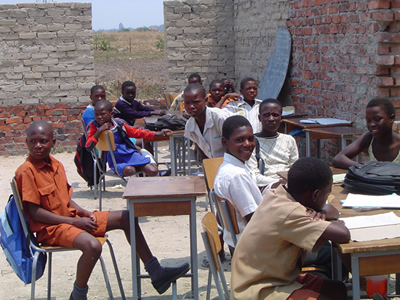Education brings hope to Tafara’s children
During my recent visit to Tafara suburb distributing the vendor wrapper with Zanele, we came across a private primary school. Some people may ask what’s so special about this school since in most suburbs there has been an upsurge in the number of private schools operating. What really attracted me to this school is the fact that nowadays it’s impossible to find someone who can volunteer to offer a service for no charge.
Chiedza/Khanyiso is a private school situated in Tafara suburb with another branch in Sunningdale. Founded in the year 2005 under the name Chiedza/Khanyiso which means light, the school is a symbol for hope to so many little children attending lessons. The school enrols children from grade one up to six and the fascinating part is the way lessons are conducted at this school. There are two building structures, one is a church building without a roof and the other structure that looked like it was about to fall down, has benches made from wooden poles and it has no floor. Grade ones and twos share the makeshift building and lessons are conducted concurrently with grades three up six doing their lessons in one room in the roofless church building.
During my interview with Mr Chikwanha who is the overseer of the school, he said, “the main motivation behind running a school like Chiedza/Khanyiso is to assist children without birth certificates and those who can’t pay fees at government schools.” Mr Chikwanha a former teacher with over 40 years experience runs the school with assistance from two female volunteer teachers who showed pride in their work when we interviewed them. When we got the invitation to see the grade one and two classroom we saw faces filled with joy and hope. On the issue of birth certificates Mr Chikwanha said he approached the Registrar General’s Office and he managed to get assistance and some the children at school now have birth certificates. The school also gets assistance from the Salvation Army Church, which owns the church building being used as a classroom, and recently they received a donation of school uniforms from Childline. Since we are now in summer there is a possibility that these children will skip lessons during rainy days.
Children pay a fee of $5 per term and this only covers admin expenses for the school with little to spare to buy textbooks and proper furniture said Mr Chikwanha. Under Millennium Development Goal Number 2, which aims to ensure that all children of school going age have access to primary education by the year 2015, one wonders if Zimbabwe can meet the deadline as most parents are still finding it difficult to pay school fees for their children. With the introduction of BEAM (Basic Education Assistance Module) in all government schools not all children have managed to access this fund and this has forced many parents to send their children to private schools like Chiedza/Khanyiso where they can afford to pay the low fees.



Tuesday, November 9th 2010 at 4:36 pm
Thanks for this profile of local people with the combustible mix of indignation and vision to address key issues for kids in Tafara. Though initiatives like these are often ignored and under-resourced by “big aid,” I believe donors and international NGOs need to restructure and revise their accountability requirements to focus on the minimum structure and financial controls necessary, rather than asking local groups to change. In effect, we must lower the “glass ceiling” for local groups such as Chiedza/Khanyiso School to access funding.
Let’s acknowledge the vision, structure, inherent strengths, and impact that local indigenous organizations can and do have. Rather than being the lowest common denominator of international development assistance, let’s recognize local indigenous organizations as vital to supporting genuine, demand-driven development that can genuinely challenge power asymmetries and unleash social change.
People, under the direst of circumstances, can and do pull together. This is important for all of us to remember.
Read more at:
http://www.how-matters.org/2010/11/08/missing-from-diy-aid-debate/